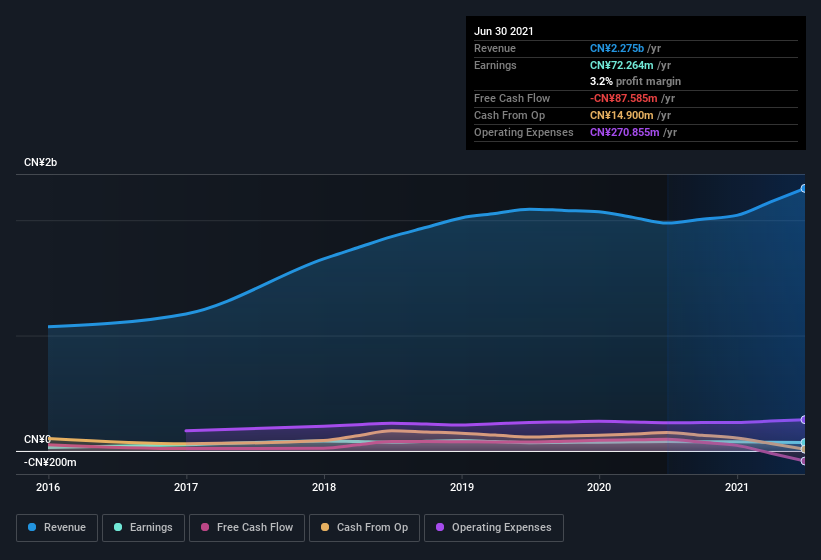Pacific Millennium Packaging Group's (HKG:1820) Problems Go Beyond Weak Profit

Pacific Millennium Packaging Group Corporation's (HKG:1820) recent weak earnings report didn't cause a big stock movement. Our analysis suggests that along with soft profit numbers, investors should be aware of some other underlying weaknesses in the numbers.
View our latest analysis for Pacific Millennium Packaging Group

Zooming In On Pacific Millennium Packaging Group's Earnings
One key financial ratio used to measure how well a company converts its profit to free cash flow (FCF) is the accrual ratio. In plain english, this ratio subtracts FCF from net profit, and divides that number by the company's average operating assets over that period. This ratio tells us how much of a company's profit is not backed by free cashflow.
Therefore, it's actually considered a good thing when a company has a negative accrual ratio, but a bad thing if its accrual ratio is positive. While having an accrual ratio above zero is of little concern, we do think it's worth noting when a company has a relatively high accrual ratio. To quote a 2014 paper by Lewellen and Resutek, "firms with higher accruals tend to be less profitable in the future".
Pacific Millennium Packaging Group has an accrual ratio of 0.21 for the year to June 2021. We can therefore deduce that its free cash flow fell well short of covering its statutory profit. Even though it reported a profit of CN¥72.3m, a look at free cash flow indicates it actually burnt through CN¥88m in the last year. We saw that FCF was CN¥101m a year ago though, so Pacific Millennium Packaging Group has at least been able to generate positive FCF in the past. The good news for shareholders is that Pacific Millennium Packaging Group's accrual ratio was much better last year, so this year's poor reading might simply be a case of a short term mismatch between profit and FCF. As a result, some shareholders may be looking for stronger cash conversion in the current year.
Note: we always recommend investors check balance sheet strength. Click here to be taken to our balance sheet analysis of Pacific Millennium Packaging Group.
Our Take On Pacific Millennium Packaging Group's Profit Performance
Pacific Millennium Packaging Group's accrual ratio for the last twelve months signifies cash conversion is less than ideal, which is a negative when it comes to our view of its earnings. Because of this, we think that it may be that Pacific Millennium Packaging Group's statutory profits are better than its underlying earnings power. In further bad news, its earnings per share decreased in the last year. Of course, we've only just scratched the surface when it comes to analysing its earnings; one could also consider margins, forecast growth, and return on investment, among other factors. If you want to do dive deeper into Pacific Millennium Packaging Group, you'd also look into what risks it is currently facing. Every company has risks, and we've spotted 3 warning signs for Pacific Millennium Packaging Group (of which 2 don't sit too well with us!) you should know about.
Today we've zoomed in on a single data point to better understand the nature of Pacific Millennium Packaging Group's profit. But there is always more to discover if you are capable of focussing your mind on minutiae. For example, many people consider a high return on equity as an indication of favorable business economics, while others like to 'follow the money' and search out stocks that insiders are buying. While it might take a little research on your behalf, you may find this free collection of companies boasting high return on equity, or this list of stocks that insiders are buying to be useful.
New: Manage All Your Stock Portfolios in One Place
We've created the ultimate portfolio companion for stock investors, and it's free.
• Connect an unlimited number of Portfolios and see your total in one currency
• Be alerted to new Warning Signs or Risks via email or mobile
• Track the Fair Value of your stocks
This article by Simply Wall St is general in nature. We provide commentary based on historical data and analyst forecasts only using an unbiased methodology and our articles are not intended to be financial advice. It does not constitute a recommendation to buy or sell any stock, and does not take account of your objectives, or your financial situation. We aim to bring you long-term focused analysis driven by fundamental data. Note that our analysis may not factor in the latest price-sensitive company announcements or qualitative material. Simply Wall St has no position in any stocks mentioned.
Have feedback on this article? Concerned about the content? Get in touch with us directly. Alternatively, email editorial-team (at) simplywallst.com.
About SEHK:1820
Pacific Millennium Packaging Group
An investment holding company, manufactures and sells packaging materials in the People’s Republic of China.
Slightly overvalued with imperfect balance sheet.
Similar Companies
Market Insights
Community Narratives




